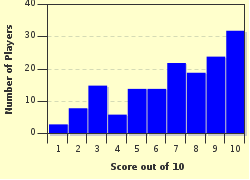Quiz Answer Key and Fun Facts
1. Anne Bronte, like many people in the nineteenth century, contracted tuberculosis. How old was she when she died from that disease?
2. When the Bronte sisters took on male pseudonyms, who was Anne Bronte?
3. Who was the author of these biographical coments regarding Anne Bronte? "The choice of subject was an entire mistake. Nothing less congruous with the writer's nature could be conceived. The motives which dictated this choice were pure, but, I think, slightly morbid." These remarks come from a clear minded, forceful person who knew her well. Who is it?
4. What was the name of Anne Bronte's coming-of-age novel? As was the custom, it was often published with the name of the person growing up.
5. Which Anne Bronte poem reveals her reading of the famous Samuel Johnson's poem which begins, "Let Observation with extensive View, Survey Mankind from China to Peru"?
6. What is the name of the kingdom Anne and Emily created, a kingdom which was very unlike the kingdom created by Branwell and Charlotte?
7. In her major novel, "The Tenant of Wildfell Hall," Anne Bronte uses the narrative consciousness of an unperceptive narrator, Markham, to expose inner limitations of this narrator. For years, readers have read this novel as though it was a story of characters and not also a novel of language, perception and inner quavering. Who is this unperceptive narrator whose story involves his perception of what he cares about?
8. The novel "Agnes Gray" begins with "all true histories contain instruction." In a probing investigation of social instruction, "The Tenant of Wildfell Hall" deftly shows limitations regarding the perception and treatment of women in the Victorian era. It also has one of the most independent and creative women characters in Victorian fiction. This masterwork mocks and magnifies the incongruities and ironies of mastery and slavery. In it, what is the name of Helen's first husband, who is highly similar to Branwell Bronte in his thoughtless, cruel drunkenness?
9. Bronte's "Tenant" has been praised for its post-structuralist shape. The novel opens with Gilbert writing to Halford in 1847. However, Gilbert's actual account of events is twenty years earlier, beginning in 1827 when he tells of the arrival of a new mysterious tenant. Who is this new artistic tenant who has just abandoned a failed and brutal marriage?
10. Anne Bronte's novels further explore writings of her sisters. "The Tenant" shares many themes regarding love and identity with those in Emily Bronte's "Wuthering Heights." "Agnes Grey" concludes with an earned marriage, not an explosion of romantic love. Its conclusion is in this way similar to Charlotte Bronte's "Jane Eyre." What is the name of the man who marries Agnes?
Source: Author
Windswept
This quiz was reviewed by FunTrivia editor
MotherGoose before going online.
Any errors found in FunTrivia content are routinely corrected through our feedback system.

